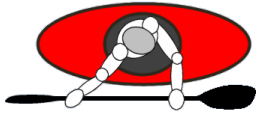|
RELATED TOPICS: Coaching Index | Bow Rudder STERN RUDDERINTRODUCTIONThe stern rudder is a steering stroke used to control the direction of the kayak. Stern Rudders are most commonly used when surfing allowing directional control of the boat. The stern rudder is assessed as part of the BCU 2 star award. TECHNIQUEConventional boats use a rudder at the rear (stern) of the boat for direction control. When the rudder turns one way it deflects water causing a force to be exerted and this in turn induces a change in direction of the boat. In kayaking, the stern rudder is essentially mimicking this action. The stern rudder is only effective when the boat is on the move. The basic stern rudder is achieved as follows (flat water):
Remember to lead with your head, so keep looking forward as that is the direction the boat is travelling in. To induce a turn in the opposite direction you can either switch the stern rudder to the opposite site of the boat or push the front arm even further across the deck of the boat and pull the rear blade in close to the stern (this can be tricky!). FAULTSThere are a number of common faults with the stern rudder. The following table recommends a remedy for each identified fault.
ADVANCED TECHNIQUESThe turn induced by the stern rudder can be made more effective by feathering the shaft of the paddle either 45 degrees clockwise or 45 degrees anticlockwise (depending on which way the turn is to be induced). With the paddle in the neutral position (parallel to the boat travelling in a straight line), feather the paddle up to 45 degrees clockwise. The boat should start to turn. When used in conjunction with ruddering the induced turns are much more effective. The feathering technique is also very useful for causing the boat to turn to the side that the paddle is not on. For example, with the paddle on the right side of the boat, with a 45 degree anti-clockwise feather of the shaft the boat should start to turn to the left. Forward paddling can be stroke linked into a stern rudder by converting the last forward stroke into a rudder. This is often useful on surf when you need to paddle forward to catch the wave the need to switch to a stern rudder for direction control. If you capsize during a stern rudder the paddle is nearly in the correct position for a reverse screw roll. Why not use this to right yourself quickly. COACHING POINTS
EXERCISE
Here is a little fun exercise that can be used to practice a good stern rudder technique.
It helps significantly at the start if paddlers communicate with each other which side they will pass each other and who shall hold their paddle slightly higher for the exchange. REMARKSOften an assessor will require the stern rudder to be demonstrated by moving the boat in a straight line using a stern rudder to one side. Make sure you practice the stern rudder on both sides. |
